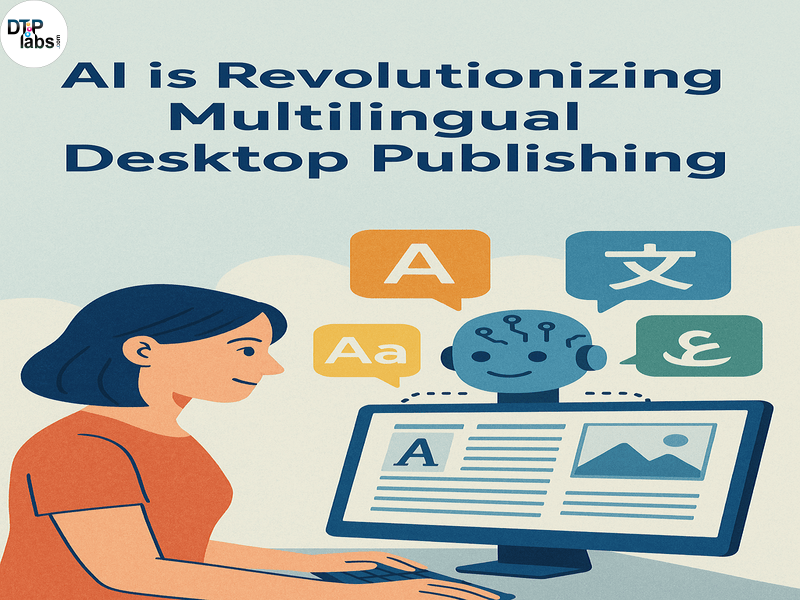In today’s fast-paced digital world, businesses and organizations communicate across multiple languages and regions. This has made multilingual desktop publishing (DTP) more important than ever. The process of creating, formatting, and designing documents in different languages requires precision, efficiency, and consistency. With the rise of artificial intelligence (AI), the way multilingual DTP is handled has transformed significantly. AI is making the process faster, reducing human errors, and ensuring high-quality results.
Enhancing Efficiency in Document Formatting
One of the biggest challenges in multilingual desktop publishing is formatting. When translating content into different languages, the text expands or contracts, affecting the overall layout of a document. In the past, designers had to manually adjust text boxes, line breaks, and spacing to ensure readability. AI-powered tools now automate these tasks, making adjustments in real time. These tools analyze the structure of a document and intelligently rearrange elements, reducing the time spent on manual corrections.
For instance, AI-driven software can detect differences in word length between languages and adjust spacing accordingly. This is particularly helpful in languages like German, where words are longer, or in Asian languages, where characters take up different amounts of space. By using AI, designers can focus more on refining the visual appeal of documents rather than spending hours fixing alignment and spacing issues.
Automating Font and Style Adaptation
Different languages require different typographic considerations. Some languages, such as Arabic and Hebrew, are written from right to left, while others like Chinese and Japanese use unique character sets. AI simplifies the process by automatically selecting the correct fonts and styles based on language preferences.
AI tools can also recognize and maintain branding elements, ensuring that translated content remains visually consistent with the original design. This is particularly important for global brands that need to keep their corporate identity intact across multiple languages. Instead of manually selecting fonts and adjusting styles for each language, AI-powered systems can apply the correct settings instantly, saving time and effort.
Improving Image and Graphic Localization
Multilingual DTP is not just about text; images and graphics also need to be adapted for different cultures. AI can analyze images and suggest culturally appropriate alternatives. For example, a marketing brochure designed for a Western audience may feature images that are not suitable for an Asian market. AI-driven image recognition tools can identify such issues and recommend replacements that align with the target audience’s cultural preferences.
Additionally, AI can help with text extraction from images, making it easier to translate embedded text. This eliminates the need for manual text replacement, which can be time-consuming. By automating these processes, AI ensures that localized content is both visually appealing and culturally appropriate.
Streamlining Quality Control
Ensuring accuracy and consistency in multilingual documents is critical. AI-powered quality control tools can scan documents for formatting inconsistencies, missing elements, and language errors. These tools compare the original and translated versions, flagging any deviations that may impact readability or design.
For example, AI can detect if a translation exceeds the allowed space in a text box and suggest alternative phrasing. It can also identify missing punctuation, incorrect fonts, or misaligned elements. By catching these errors early, AI reduces the risk of costly revisions and rework, making the process more efficient.
Enhancing Collaboration Between Teams
Multilingual desktop publishing often involves collaboration between designers, translators, and project managers. AI-powered platforms facilitate seamless communication by integrating translation and design tools. Cloud-based AI solutions allow teams to work on the same document simultaneously, ensuring that changes are made in real time.
For instance, if a translator updates a sentence, the AI system can automatically adjust the formatting without requiring manual intervention from the designer. This reduces turnaround times and ensures a smooth workflow. With AI-driven collaboration, teams can complete multilingual projects faster while maintaining high-quality standards.
The Future of AI in Multilingual Desktop Publishing
As AI technology continues to advance, its role in multilingual DTP will only grow stronger. Future developments may include even more sophisticated text recognition, advanced layout optimization, and real-time translation capabilities. AI-driven tools will become more intuitive, learning from previous projects to provide even better recommendations.
Companies that embrace AI in their desktop publishing workflows will benefit from increased efficiency, reduced costs, and higher-quality outputs. Instead of spending days or weeks manually adjusting layouts, AI-powered systems can complete tasks in a fraction of the time. This allows businesses to reach global audiences more effectively without compromising on design or accuracy.
Conclusion
AI is transforming multilingual desktop publishing by automating complex tasks, enhancing accuracy, and improving efficiency. From formatting adjustments and font adaptation to quality control and team collaboration, AI-powered tools are making it easier to create high-quality, multilingual documents. As AI continues to evolve, the future of multilingual DTP looks promising, offering faster, smarter, and more reliable solutions for global communication. Businesses that leverage AI in their publishing workflows will be better equipped to meet the demands of an increasingly connected world.
DTP Labs is a desktop publishing company based in New Delhi, India. We offer book publishing Services, PDF to Word conversions, post-translation DTP, and e-Learning localization services to translation agencies worldwide. To avail of our services, check out our website www.dtplabs.com , or contact us at info@dtplabs.com.

